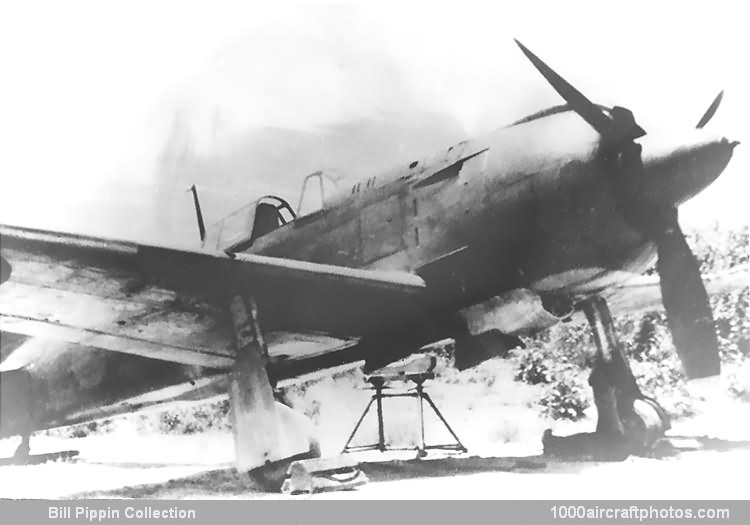But the new fighter, the Kawasaki Ki.100-Ia Type 5 Fighter, Model 1A, was not an entirely new machine. It was an improvisation forced upon the IJAAF by mounting stocks of Ki.61-II Hien airframes and diminishing supplies of Kawasaki Ha.140 liquid-cooled engines.
By the end of 1944 275 Ki.61-II airframes were standing at Kawasaki factories with little likelihood of ever receiving Ha.140 engines, deliveries of which had dropped to a mere trickle. The fighters were required urgently by the IJAAF, and there was no alternative but to install a different engine. However, the only engine offering a suitable output was the 1,500 hp Mitsubishi Ha.112-II Type 4, a large-diameter fourteen-cylinder air-cooled radial which appeared totally unsuited for marriage to an airframe designed for a slim liquid-cooled engine.
Nevertheless, Kawasaki engineers undertook the conversion, the first of three Ki.61-II airframes fitted with the Ha.112-II flying on February 1, 1945. The adaptation immediately proved to be far more successful than the most sanguine expectations could have foreseen, and as the Ki.100-Ia Type 5 Fighter, Model 1A the existing stock of Ki.61-II airframes was quickly converted to take the radial engine, 36 being delivered in March, 89 in April, and 131 in May. Armament consisted of two 0.787 in (20 mm) Ho-5 cannon and two 0.50 in (12.7 mm) Type 103 machine guns.
With the completion of these conversions, the fighter was built from the ground up as the Ki.100-Ib Type 5, this differing from the original model solely in having an all-round-vision hood similar to that developed for an experimental version of the Ki.61-II-KAI. By July 23, 88 Ki.100-Ib fighters had left the plant at Kakamigahara (precently Gifu JASDF base), when production was seriously disrupted by aerial attacks, and only 378 Ki.100s of both versions had been completed at Kakamigahara when production terminated on August 10, twelve additional machines being built elsewhere.
In March 1945, an attempt to improve the altitude potentiality of the basic design resulted in the start of work on the Ki.100-II with an Ha.112-IIru engine. This engine was fitted with an Ru.102 turbo-supercharger and a methanol/water injection system to boost output for short bursts. The turbo-supercharger was placed below the engine and displaced some of the fuel system components, but space limitations prohibited the installation of an aftercooler and its associated ducting, and air was ducted directly from the compressor to the carburetor.
The Ki.100-II flew within six weeks of development being initiated, the second within eight weeks and the third within ten weeks. The lack of an intercooler limited the high-altitude performance of the Ki.100-II, and the turbo-supercharger added 600 lb (272 kg) to its weight, reducing maximum speed by approximately 15 mph (24 kmh) at 10,000 ft (3,048 m). However the boosted power at 30,000 ft (9,144 m) gave the Ki.100-II a 30 mph (48 kmh) speed advantage over the initial model at this altitude, although both types possessed the same service ceiling.
Ki.100 fighters, which had no allied reporting name assigned, were primarily assigned to the defense of the home islands, operating from Chofu and Yokkaichi from the spring of 1945."
